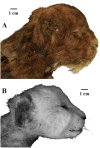Mummy of a juvenile sabre-toothed cat Homotherium latidens from the Upper Pleistocene of Siberia
- PMID: 39543377
- PMCID: PMC11564651
- DOI: 10.1038/s41598-024-79546-1
Mummy of a juvenile sabre-toothed cat Homotherium latidens from the Upper Pleistocene of Siberia
Abstract
The frozen mummy of the large felid cub was found in the Upper Pleistocene permafrost on the Badyarikha River (Indigirka River basin) in the northeast of Yakutia, Russia. The study of the specimen appearance showed its significant differences from a modern lion cub of similar age (three weeks) in the unusual shape of the muzzle with a large mouth opening and small ears, the very massive neck region, the elongated forelimbs, and the dark coat color. Tomographic analysis of the mummy skull revealed the features characteristic of Machairodontinae and of the genus Homotherium. For the first time in the history of paleontology, the appearance of an extinct mammal that has no analogues in the modern fauna has been studied.
© 2024. The Author(s).
Conflict of interest statement
Figures







References
-
- Boeskorov, G. G. et al. The preliminary analysis of cave lion cubs Panthera Spelaea (Goldfuss, 1810) from the permafrost of Siberia. Quaternary.4(3), e24 (2021).
-
- Grigoriev, S. E. et al. Paleontological and archaeozoological studies in Yana River Basin. Vestnik North-Eastern Fed. Univ.57(1), 20–35 (2017).
-
- Smuts, G. L., Anderson, J. L. & Austin, J. C. Age determination of the African lion (Panthera leo). J. Zool.185(1), 115–146 (1978).
-
- Rawn-Schatzinger, V. Development and eruption sequence of deciduous and permanent teeth in the saber-tooth cat Homotherium serum Cope. J. Vertebr. Paleontol.3(1), 49–57 (1983).
-
- Figueirido, B., Lautenschlager, S., Pérez-Ramos, A. & Van Valkenburgh, B. Distinct predatory behaviors in scimitar- and dirk-toothed sabertooth cats. Curr. Biol.28(20), 3260–3266 (2018). - PubMed
MeSH terms
LinkOut - more resources
Full Text Sources
Miscellaneous

